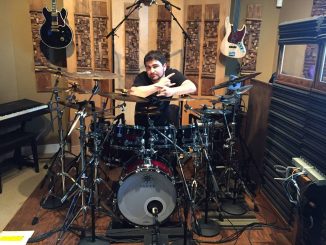We are honored and excited to welcome Brian Zink of Battlecross to SDM! Brian is an absolutely insane drummer, and we are more than excited to see what his new lesson Vlog series will bring.
Brian plays drums for Battlecross and The Accents. He’s into Pina Coladas and getting caught in the rain. Aside from crushing it with bands like Battlecross, he has, and is a drum tech for bands like Shadows Fall, Flotsam and Jetsam, and Overkill (when schedules align) and is located in the upstate New York area where he offers in-person and remote private instruction.
Brian is also available for studio and session work so don’t hesitate to contact him. If you’re interested in booking, have questions, or just want to let him know that you too are into Pina Coladas, please reach out at ‘bzndrummer [at] gmail.’
Brian proudly plays the following:
- Pearl Drums
- Zildjian Cymbals
- Vic-Firth Drumsticks
- Remo Drumheads
- Drum Workshop Pedals
- Roland Electronics
- Kelly SHU Bass Drum Mic
- Kick Pillow Bass Drum Dampener
Lesson 1: Five Tips on Posture When Setting Up Your Drums
Seat/Throne Height:
Seat/Throne height is always a highly debated topic and for me, I believe there is no 100% correct answer to this question. Everyone’s body type is different and therefore there is no grand unifying answer that will work for every player all the time. Some will sit a little higher, some a little lower, some closer, and some further back. What’s important is knowing how to calibrate this correctly for yourself. Then, once you figure out what position is best for you, the next step is coming up with a way to remember it. This is also the root of where proper posture begins, so it’s not something you want to overlook.
It’s generally accepted that the angle of your legs when seated should be at about 90 degrees. However, I don’t believe this is a hard and fast rule. I am a short person, so I tend to sit a little higher to increase this angle simply because it feels more comfortable to me (and because I am vertically challenged, and most thrones don’t have a low enough setting to achieve a perfect 90 degrees… just the way she goes I guess). To explain this by example, I at 5’ 8” will likely have a much different seat height than the 6’ 5” behemoth that is Danny Carey. However, with the correct seat height specific to each of us, we can likely both achieve a comfortable leg position at or around 90 degrees despite the variance in stature.
Once you find your seat height, how do you remember it? This is important because maybe you’re not using your kit at a gig or you want to experiment with seat height but want to remember where the original position was. The best way that I have found to do this is to put a drumstick under the seat vertically then add a finger on top until you hit the bottom of the seat. This means that anytime I have to adjust a throne, I know that it’s one stick and one finger and that’s where I’ll move the bottom of the throne to.
Foot Position and Pedal Placement:
Once you get your throne height situated, the next step is to determine where your pedals should be. There is a pretty easy way to do this. All you need to do is sit down on the throne, relax, lift your legs, and let them fall naturally. If you’re relaxed, they should fall into the most comfortable and natural position. Your legs and feet should be equidistant, and you shouldn’t feel any tension or stretching. Mark this on your rug or better yet, slide the pedal(s) under your foot to get the position set. Once they’re in place, simply slide the rim of the bass drum into the hoop clamp of the pedal, and now you can move on to the next step, the snare drum.
Snare Placement and Height:
In the same manner, we determined our optimal pedal placement, this makes use of the same concept. Grab a pair of sticks, sit on the throne, and put your feet on the pedals. Relax your arms and lift your wrists. Just like before, let them fall naturally. The tips of the sticks should land in the area that you’ll want the center of your snare to be. Position your snare in this area so the center lines up with where the tips of the sticks fell.
As far as the height is concerned, this is very much a personal preference. Some drummers keep it low to really drive through the drum. Some drummers keep it much higher so that the rim of the drum is in line with their navel. The philosophy here is that the height of the drum resembles the height of a desk if you were sitting in an office chair allowing for the least amount of resistance when playing. For me, this was never the most comfortable and I have come to find over the years that if I lay a stick across the rim of the drum, it will line up directly with my waist. Again, much of this is a personal preference so be sure to experiment with the height and angle to find what works best for you and your style of playing.
Setting Up The Drums:
Up to this point, we worked through setting up the most vital components of the drums set. Getting your Snare, Bass Drum(s), and Hi-hat positioned correctly creates the best foundation on which to build the remainder of the kit. The most important thing to keep in mind here is that you’ll want to set it up ergonomically. This means the toms and cymbals should be positioned in a manner relative to the player and not the other way around. Many drummers make the mistake of setting their drums up and then bending and reaching to strike things and this is something we want to avoid as it can lead to inefficient motion and injuries. If set up correctly, you should find that you won’t need to bend and stretch to strike things and that there is a natural physical flow to the drums.
We’ll use the same technique to determine where to place the toms. While sitting, feet on the pedals, and sticks in hand you’ll extend your arms out to their most comfortable position. You’ll now begin to turn from your hips and the tips of the sticks should trace the path where your toms and floor toms should land. By doing this, you’ll ensure that the drums are situated in a way that allows you to play in the most uninhibited and natural way. Do the same for the cymbals and you’re on your way to a much better playing experience. Everything should be set up within an area of activity relative to your reach and its relation to the motion of your hips so you’re never extending too far to reach things.
Using a Mirror:
Although this may sound odd to some, do not underestimate the value a strategically placed mirror can have. Better yet, a few mirrors. Doesn’t need to be one of those fancy designer expensive ones either! Just go buy a couple of cheap mirrors and put them around your practice space. This will tell you more about your posture, physical approach, and technique on the drums than you can imagine. For example, it’s difficult to tell if you’re slouching or leaning without being able to see yourself, especially if you’re practicing every day you’ve naturally slipped into this. However, the use of the mirror will make you aware of the issue immediately. Once you can see yourself play, you may realize you were leaning way too far forward and never noticed and now you can work toward correcting this.
You can self-monitor all different kinds of things by being able to see yourself play. Issues that may have gone unnoticed that developed into bad habits can be avoided before they start and things that are bad habits can be corrected easier. This isn’t limited to posture either. Working on foot technique? Lay the mirror down at an angle so you see exactly how your foot is contacting the pedal. Working on Moeller exercises on a pad? Put the mirror right in front of you so you can see if your hands, wrists, and arms are moving properly.
If you’d like a full layout of the gear in the video you just saw or have requests for upcoming lesson material you’d like to see let us know!
Zink’s Links:
Facebook: https://www.facebook.com/brian.zink.1232/
Instagram: https://www.instagram.com/bzndrummer/?hl=en
YouTube: https://www.youtube.com/channel/UCLwB3e5CZ1ab5LXMULjxdsA




